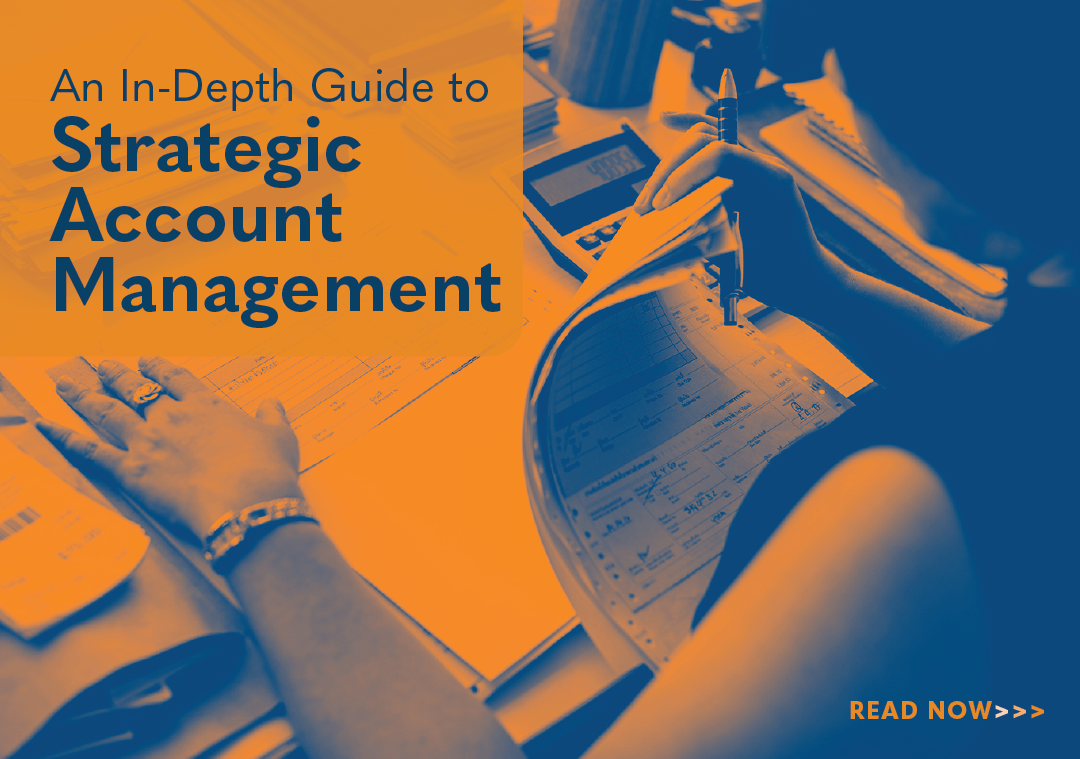An In-Depth Guide to Strategic Account Management

One buzzphrase swirling around the salesworld is Strategic Account Management or SAM. This is also called Key Account Management. Unlike a lot of trendy words or concepts, SAM is a legitimate, logical strategy. More importantly, it plays a major role in ensuring the long-term viability of your organization.
According to Gartner, 70 percent of CSOs say delivering higher returns from key accounts is a priority. However, current account management channels fall short. In fact, only 28 percent of sales leaders agree these regularly meet cross-selling and account growth targets.
What is Strategic Account Management?
SAM is a methodology that involves identifying important accounts and cultivating mutually beneficial relationships. Unlike sales, which often focuses on the short term, SAM takes a long-range view. Hence, the best strategic account manager is not necessarily your best sales rep. More on that later.
What is a Strategic Account Manager?
As a sales leader, if you have taken the time to identify your most strategic accounts, it’s time to identify who your strategic account manager will be. You may be tempted to place a sales rep in the role of your strategic account manager but that would be a mistake. Your strategic account manager should be more focused on long-term success, rather than an immediate sale. Where a salesperson may have a hunter mentality, the strategic account manager is a nurturer.
The strategic account manager will be a subject matter expert for your company. They will take the time to look for new opportunities (problems that can be solved) and create new solutions for the customer. For example, a client reveals their operation is spread out in a dozen regions, with each region having a department director. The directors are creating individual reports in Excel and your client is lacking real-time access to data or KPI dashboards. This is an instance where the strategic account manager can improve the business processes across the client’s organizations, improving their outcome and increasing value for both parties.
The strategic account manager will help clients solve both specific problems relating to your solution and business problems relating to the client’s operations. In the example above, the specific problem is dealing with data that does not share information across the organization. The business problem is inefficiency, because the client is forced to manually create and share reports costing them time and money every day. In general, salespeople are good at solving specific problems, while strategic account managers have the time and skillset to assess the larger picture and move to solving underlying business problems. This makes their skillset different than the ones salespeople possess. The core competencies you want to look for in a strategic account manager include:
- Account Management Skills
- Organization & Planning Skills
- Problem Solving
- Market Awareness
- Strategic Thinking
- Analytical Skills
As the primary contact with valuable clients, strategic account managers end up working alongside key decision-makers at the client’s organization, supporting them with their business outcomes. Therefore, they should possess a strong aptitude for analysis and problem-solving. Because strategic account managers will need to stay abreast of industry trends, they will need a continuous learning mindset.
Why should we use strategic account management?

Simply, it’s the best way to guarantee long-term profitability for your organization. The 80/20 ratio states 80 percent of your business comes from 20 percent of your customers or sellers. While that’s overly simplistic, the underlying concept is valid. Strategically, focusing on key accounts will generate the largest long-term ROI from your resources.
If you think you already focus on your biggest clients, you’re missing the big picture. In many cases, your largest accounts will also be strategic accounts. However, that’s not always the case.
Part of strategic account management is identifying buyers with the greatest potential. After recognizing them, you can develop your relationships, so they grow into larger clients.
How do we determine who should be our strategic accounts?
This is a multistep process. First, set criteria for evaluating current clients. Then, come up with a Strategic Score. You may use whatever term you want for your final quantifiable sum. However, use enough criteria to differentiate between accounts. Just don’t use so many that you risk designating the wrong accounts as strategic.
Some areas to consider:
- Likelihood of continued relationship
- Client’s ability to grow as a company
- Product/service fits to client needs
- Projected revenue potential
- Pre-existing personal relationships
- Client’s current financial health
Notice how many areas involve the client’s current position, state, and potential upside. That’s a good way to see beyond your current largest accounts. Now, you can identify up-and-comers that can grow with your organization. Remember, SAM isn’t just about right now. It’s about the long game and looking further down the road.
Strategic account management works on the philosophy that your best source of new revenues is your current customer base. Identifying which customers to invest in and providing dedicated resources for growth is critical. Strategic account management is less about upselling or cross-selling, and more about partnering and problem-solving. The long-term business benefits of strategic account management are indisputable; you will keep your best customers longer, increase their value over time, and lower your client acquisition costs. Allowing your best customers to manage themselves is not a strategy. Creating a strategic account management plan is the path to predictable revenue and organic growth.
Additionally, make sure you save this process. As you gain clients, input their details into the system. This gives you a sense of whether you should make them a strategic account. Do this as soon as possible after acquiring their business. This way, you can keep a strategic account pipeline operating parallel to the sales pipeline.
Who should be the strategic account managers?
Once you’ve ranked existing clients by strategic account suitability, you can plan your SAM structure. Naturally, your priority should be determining strategic account managers.
Gallup research shows the importance of account managers. They note 40 percent of B2B customers who are very satisfied with their account manager are fully engaged. If they are not very satisfied, this drops to 13 percent. Also, with only 29 percent fully engaged, 71 percent are at risk of leaving for a competitor.
Some organizations promote their top sales reps. Or else they turn a sales manager into an account manager. These are mistakes. The reality is, all three of those roles require distinct skill sets. You might think that sales managers and account managers are interchangeable. After all, both require management skills. But they aren’t the same.
Sales managers manage people. Strategic account managers manage relationships. It’s a subtle but important distinction.
A sales manager coaches their sales reps. They help their team members hit targets (whether KPIs, sales numbers, or both). They then develop reports so sellers can improve.
A strategic account manager cultivates relationships with the stakeholders of their portfolios. They monitor each client. As a client’s needs and objectives change, strategic account managers identify opportunities to expand the relationships. Some of the main skills needed include the following:
- Patience
- Organization
- Relationship building
- Emotional intelligence
As account growth can be a lengthy process, strategic account managers must be patient. It’s rare that a rapid change in a client’s requirements presents an opportunity. But when it does, be prepared.
Account managers work with many clients. And each has multiple important players. This is not only true for clients, but your organization as well. These days, most buying decisions require a consensus of many diverse stakeholders.
When issues arise, relationship support and maintenance may require experts. Account managers typically coordinate service requests.
Within such a web of personalities, strategic account managers must maintain their composure. A big part of the job description is “managing” their own and other’ emotions.
How many accounts should each strategic account manager have?
There’s no rule for this. It depends on your unique situation. A key account may be a revenue generator, but it needs a lot of high touches and service. You’d then dedicate an account manager to just that account.
Conversely, you might have many moderate revenue accounts that don’t require as much contact. For these, you can assign numerous accounts to one manager. Of course, this requires monitoring. As the number and demands of key accounts change, distribute their maintenance to account managers as needed.
Your initial number of managers depends on the size, complexity, and contact requirements of your strategic accounts. There’s no formula for this. It’s something you’ll need to calculate during the process.
How many contacts/touches per client should strategic account managers strive for?

This depends on the account. Some want or need more frequent contact, whether emails, follow-ups, meetings, check-ins, etc. One way to find out what each account prefers is to ask the client.
Next, determine a cadence for that account and stick to it. Think of your cadence as a promise. It ensures regular contact, check-ins, and support. Failing to honor that promise harms the relationship.
How should account managers expand business with existing accounts?
This is a complex question. And like figuring out your strategic accounts, it’s a multistep process:
Step 1 – Build a thorough customer profile for each account.
- Who are the stakeholders involved in purchasing decisions?
- What are their target markets?
- What are their short- and long-term goals?
- What are the specifics of their industry and offerings?
- Who is their primary competition?
Step 2 – Draft a needs assessment for each account.
- Identify the intersections between current and future problems
- Determine the fitness of your offerings.
Step 3 – Create a contact cadence plan, including:
- Phone calls
- Videoconference
- In-person
Use a range of contact types, and always tailor the type of contact to the need. Problems may require a more personal touch, such as video or in person. The same may be true of opportunities, like adding service. Also, account growth necessitates more frequent communication and contact.
Step 4 – Write up a Strategic Account Plan
Typically, this is a one-to-three-year roadmap. It should show how the relationship will proceed and grow. Include the following:
- Customer profile
- Needs assessment
- Account cadence
- Clear direction for both the account manager and account
- Feedback/adjustments from the account
Sharing this with the client is essential. It ensures uniformity and clear expectations. It also avoids surprises and shows the client this isn’t a one-off transaction. You are invested in the relationship.
This is why selecting the right clients to be strategic accounts is so critical. Some might tick all the boxes. However, they may not yet be interested or able to form strategic relationships.
Step 5 – Track account progress. This should include:
- Metrics
- Benchmarks
- KPIs
- Timeline
- Update stakeholders/decision makers
These should assess how relationships are progressing and when to create or execute an opportunity for growth. Account managers should keep tabs on these things.
But it’s also important to consider it from the client’s perspective. Perhaps the timeline for increasing business has changed. Maybe key stakeholders have shifted, or the decision-making process has evolved. There might be other indicators the agreed-upon strategic account plan needs adjusting.
Remember, this is a bilateral arrangement. It is a partnership where organizations and strategic accounts work together for mutual benefit.
Watch Out for These Errors That Can Doom Your Strategic Account Management

We’re revisiting the topic of Strategic Account Management (SAM) today. The last time we visited this subject, we provided you a comprehensive, in-depth guide into what SAM is and some of the best practices to ensure a successful SAM program. In this edition, we’ll be looking at the inverse – the mistakes that will cause your strategic account management efforts to fail.
- You’re communicating too frequently (or not enough).
On the one hand, SAM is about maintaining regular contact and developing relationships with your most important or highest potential accounts. On the other hand, too much contact can make you seem like a bothersome pest. Where the line falls is going to vary from account to account – some will welcome frequent touches and others will only want sporadic check-ins or meetings.
The converse is true as well – you can get caught up with juggling so many accounts that one accidentally falls by the wayside and is needing some love and care. If this is an account that wants more attention, that can potentially put you at risk of losing it to a more active, engaged competitor.
There are a couple things you can do to avoid falling into the too much/too little trap. First, as we mentioned in our previous SAM blog, come up with a strategic account plan that sets the guidelines and timelines for contact at the start of the relationship and get customer approval for that plan. That way, everyone is clear on the expectations and you know when and how you should be communicating with them.
Secondly, take advantage of your various calendar/reminder technology applications (including task reminders within your CRM) to set notices for yourself on when to reach out to each account. When you have a mutually agreed strategic plan, you can sometimes set these notices weeks or even months in advance. Enter the scheduled contact appointments and methods as soon as you know when and what they are. Then you’ll see the reminders as those dates come up and you won’t forget.
- You’re so focused on growing the account, you get locked into a selling mindset.
The ultimate endgame result of SAM is, of course, to expand the revenue from the account and increase the monetary value of the business relationship. But sometimes – perhaps feeling the pressure of meeting a goal or needing to get a win if in a slump – strategic account managers switch to pushing the sell when it’s not the right time to do so, or, if it is the right time, approach it from an aggressive pitch standpoint rather than the consultative, contemplative strategy that yields the highest win rate and account satisfaction.
A corollary to this is spamming the account(s) with marketing content and collateral. Some marketing content – if it’s relevant to the account’s business situation – is good. Too much and it gives off the stench of selling.
Here’s the thing: As your company’s sales reps can tell you, your accounts know you want to grow the financial relationship with them. But focus on developing the human relationship with them first and let the revenue-generating opportunities arise organically out of the discussions about how the buyer is doing and growing themselves. Let it happen naturally and let your conversations and contacts with your accounts be fruitful, relevant, and relationship-building.
- You’re unaware of the organizational or structural changes in your accounts’ organizations.
The one constant in life is change. This is particularly true in the business world, as people change employers and roles. Further, the COVID-19 pandemic has caused disruption in many industries, accelerating the rate of change. All of this means that the key influencers and stakeholders who are critical to developing relationships with your accounts might well be different from the ones you began with.
One of the most important duties as a strategic account manager is keeping updated on how the client organization has changed – whether new people in the roles you’re communicating with or a structural reorganization that results in a redistribution of job duties. If you don’t keep tabs on these fluctuations, you might find yourself talking to the wrong people or approaching the new people in the same way as the old.
The problems with the first are quite obvious – if you’re not cultivating relationships with the right influencers and decisionmakers, you won’t have the advocates necessary to successfully expand your business when the time comes. As for the second, remember that everyone has their own individual personality, communication style, and preferred touch cadence. So you might, for example, be used to Jan, who is an expressive communicator who enjoys frequent contacts. If Bob, who is a business-oriented person who prefers only the minimal necessary touches takes on Jan’s old role and you continue with the way you’ve engaged Jan, you run the risk of irritating Bob and damaging the relationship.
As a side note to this – make sure one of your relationships within the organization is someone at the C-Suite level, where there’s final approval/sign-off of decisions. Failure to have at least one crusader in the C-Suite can either slow down the sales process when an opportunity arises or even potentially kill the deal altogether.
- You don’t know the changes that are occurring in accounts’ business situations.
The prior point is about ignorance at the human level – where relationships are forged and the groundwork is laid to move forward with expansion opportunities when they arise. But that’s not the only area where ignorance can result in lost opportunities and damaged relations. Being unaware of how a client’s industry, processes, target markets, or any other aspect of an account’s business situation can be equally harmful.
Here, the negative consequences can be missed opportunities, mistimed efforts at asking for more business, and providing information or advice that isn’t applicable to an account’s current reality. At the most extreme, this exposes you to potentially losing the account because you seem inattentive or oblivious. Remember what we said earlier – the one constant in life is change. That applies to situations as much as it does people.
To prevent this from occurring, become an expert in your accounts’ industries and stay current on the changes within them – both on an industry-wide level and on a geographic one – for example, monitoring how regulatory changes in a geographical region might impact a client there, even if those same changes in business environment aren’t occurring in other locations the client operates.
Also, as part of your outreach cadence, make sure to factor in asking about how the organization’s situation has changed – both positively and negatively. This is especially important if your touch rate is low and limited to essential communications only – you won’t have as many opportunities to find out what exactly is going on internally.
- You focus too much on the short-term, rather than adopting a long-range view.
One of the most common mistakes made by strategic account managers – particularly those who may have been promoted or transferred from sales – is paying too close attention to short-term goals and scenarios. This can lead to the aforementioned problem of being in selling mode or not being able to distinguish between when to simply further develop the personal relationship and when a genuine expansion opportunity has arisen.
Remember, while strategic account management does involve a sales component, most of your time will be spent building relationships and servicing your accounts. This is a long-term process – one that can sometimes take literal years before an opportunity for growth arises. Patience is more than virtue when you’re an account manager – it’s a necessity. And if this isn’t a personality trait you’ve developed previously, it’s one you’ll need to acquire. This is about the long game. Be flexible enough to respond to the short-term when it’s required, but always keep in mind that you are planting seeds that will bear fruit later.
- Your organization hasn’t provided you enough support.
As a strategic account manager, you’re a rockstar at dealing with numerous accounts and people. You’re well-organized, know who to talk to and how to communicate with them, and are able to cultivate and capitalize on opportunities to grow the business. But you can still fail if your organization hasn’t provided you the support you need to carry out your mission.
The reality is, supporting strategic accounts isn’t a siloed, solo effort if you want to be successful. After all, your expertise is in relationship development. If a customer has an issue or request with your service or product, there’s a strong chance it’s something that you won’t be able to unilaterally fix. You’ll need the help of other departments in your organization. But if the processes aren’t in place for you to be able to quickly touch base, get a response, and just as swiftly follow up with resolving that issue or filling that request, your clients can feel left twisting in the wind due to the delays and lag in answering their needs.
In most organizations, it’s neither realistic nor feasible to expect, for example, dedicated service technicians to report directly to a strategic account manager. The usage rate simply isn’t high enough or frequent enough for that to make sense. But you do need the clear expectations and processes established and understood by everyone in the organization so that when you do need to call on, say, the service technicians, that they’re able to swiftly link up with you and get that key account serviced.
- In expansion negotiations, you or your organization gets bogged down in the small details.
Remember you’ve spent weeks, months, even years cultivating the relationships and been patient. It’s natural by force of habit to switch to transactional thinking when it’s time to negotiate the deal, but keep in mind the bigger picture. This is a key account – the most important thing is extending the customer lifetime value and creating a win-win situation that benefits both parties. Years of work can be thrown away in a single moment of contentious debate.
So while you’re negotiating, remember this isn’t a one-off deal. This is the culmination and payoff of untold amounts of resource investment – one that will continue to be profitable and worthy ROI if you maintain the relationship and the account on the same cordial terms that led you to this moment.
Get Your Custom Sales Account Management Plan Now!
Strategic account management requires upfront planning and an investment in your people but it’s also the optimal way to increase revenue and build long-lasting partnerships. Could your team benefit from a detailed strategic account management plan? At Janek, we have the resources, experience, and expertise to help grow your key accounts organically. Learn more, contact us today.
Editor’s Note: This article, first published in July 2021, underwent revisions to enhance its coherence.

- Account Planning (16)
- Awards (42)
- Client Testimonial (37)
- Personal Branding (21)
- Podcast (12)
- Research (77)
- Sales Career Development (90)
- Sales Coaching (164)
- Sales Consulting (141)
- Sales Culture (181)
- Sales Enablement (380)
- Sales Leadership (111)
- Sales Management (267)
- Sales Negotiation (11)
- Sales Prospecting (136)
- Sales Role-Playing (19)
- Sales Training (242)
- Selling Strategies (279)
- Soft Skills (78)
- Talent Management (101)
- Trusted Advisor (29)
- Virtual Selling (57)
- Webinar (13)




























